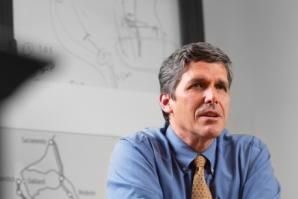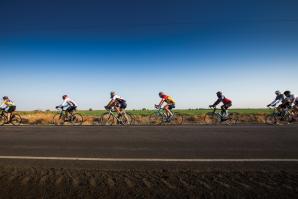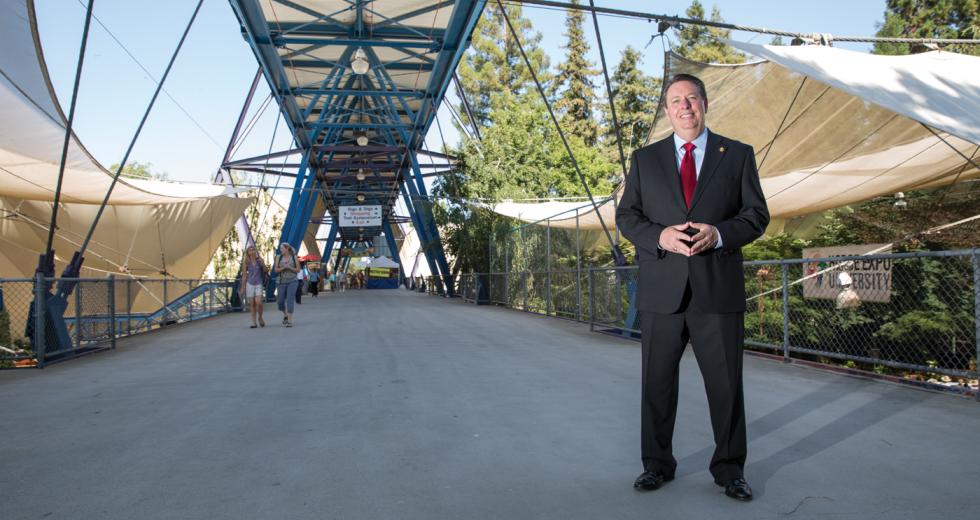A hundred years ago, the California State Fair had a sure-fire way to entertain crowds: Operators would send two steam locomotives crashing into each other at 90 mph for pure spectacle. Today, Sacramentans with an eye on Cal Expo are still thinking big.
As it gets ready to host the 160th edition of the State Fair this summer, Cal Expo is struggling to keep its 1960s buildings functional while searching for a way to do some large-scale remodeling.
Most of the fairgrounds’ buildings need tens of millions of dollars of maintenance. Cal Expo doesn’t have that much money. The state government owns the land, but the property gets no tax support.
Many of Cal Expo’s capital improvements have essentially been paid for on the backs of the horses that have raced on its track. “We basically have had to maintain ourselves with the revenue of the fair as well as the other events we have out there,” says Rex Hime, a State Fair Board member and president and CEO of the California Business Properties Association.
Even when kept up, some of the facilities are too outdated to generate revenue. At about 6,000 square feet, the smaller exhibit buildings on the west side aren’t event big enough for trade shows or consumer expos.
With no hotels on the property, Cal Expo is geared for consumer events —home and garden shows, dogs, guns, dolls — and primarily for Thursday-through-Sunday business. Cal Expo has developed some courses for 5k fun runs, but that’s a tweak rather than a breakthrough.
This wasn’t how the Cal Expo story was supposed to play out when Gov. Ronald Reagan officially opened the site in 1968. The original vision was for a Disneyland of the North. “That’s why we have the monorail and some other things out there,” Hime says.
A wire-service story from 1967 describes plans for an amusement park with an ore-car journey into a Mother Lode mineshaft, a spin through the desert in a tiny car and a log-flume ride through the redwoods. All that plus golf courses, horse and road racing tracks, a 32-acre lake for water sports and an eight-building complex where exhibits would tell of California’s past and future.
Budget cuts killed the dream.
The man charged with restoring some of Cal Expo’s shine is Rick Pickering, the park’s new general manger who has successful managed the Alameda County Fair and the Orange County Fairgrounds.
Pickering faces a chicken-and-egg problem. Cal Expo must host more events to generate revenue for upgrades, but it must upgrade to lure more events. There have been some small-scale improvements: the racetrack stands were winterized, the monorail renovated, the RV campground expanded.
Pickering has a wish list of further improvements, but he must work within a tight budget and with a staff that has shrunk by 70 percent in the past five years due to recession layoffs. He compares running Cal Expo to owning a 45-year-old house. When your water heater is shot and the roof leaks, you can forget about a new pool.
Fortunately, Cal Expo has a large backyard. The fairgrounds and parking lots cover about 470 acres. Later this year, the venue plans to hear requests from developers about what they’d do with about 120 acres adjacent to Interstate 80. The redeveloped fairgrounds would sit on the easternmost 230 acres.
This idea has been floated before. A couple of years ago, Cal Expo commissioned a study of how the property could be improved if some areas were sold off. One scenario had the racetrack area developed as housing and the opposite end of the property as retail space. The fairgrounds would have sat in the middle, buffered by parking lots.
This is state-owned land, however, so it’s not as simple as calling up a real estate broker and sticking a sign in the ground. State law would require all the proceeds from a sale to go to the state, not Cal Expo. So earlier this year, state Assemblyman Roger Dickinson introduced Assembly Bill 1069 to give Cal Expo a way to keep any such money.
The problem with selling off the land is that 120 acres is likely to net only about $60 million, which would only cover basic upkeep. “That would be just enough to put paint and duct tape on our existing problems,” Hime says.
Some estimates have put the cost of a full redevelopment at $500 million to meet the demand for modern exhibit space. The fair industry phrase is “flat and flexible.” That means, in part, that operators must be able to curtain off sections of a building to shrink or expand space as needed.
Even outside space needs to be flat and flexible. When the Orange County fairgrounds in Costa Mesa redesigned itself, it ripped out the lawn, light poles and ficus trees from its main mall, says Jerome Hoban, who oversaw the job as CEO and now runs the Alameda Fairgrounds.
“You still have a feel of nice lushness of landscape, but it’s not in the way,” Hoban says. The fairgrounds also installed a 40-foot diameter fountain, but with jets at ground level. When it’s turned off, no one knows it’s there, and the space can be used for other purposes.
Cal Expo’s option is to tear down the obsolete halls and use temporary buildings or tents, Pickering says. But exhibit tents aren’t easy to deal with. A 100,000-square-foot tent needs heating and air conditioning, plus double doors, electrical outlets, portable toilets, Internet and fire sprinklers.
“When it rains, think of the water coming off of that roof,” Pickering says. There had better be proper drainage to keep water from coming back under the tent.
Tents are good for trying out new configurations and crowd flow, but aren’t a long-term solution, Hoban says. They can cost $30,000 to $90,000 to rent. Do that for a few years, and you’ve spent the cost of a permanent building.
Cal Expo could borrow money or lease out acreage to pay for upgrades, but those paths have their limits, too. State law lets the fair keep proceeds from leases of only 20 years or less. With a longer lease or an outright sale of land, all proceeds would go to the state.
Cal Expo is also looking at the possibility of a public-private partnership to redevelop the entire fairgrounds.
“There are entities out there that develop worldwide entertainment centers. I believe if we were to sit down and chat with them we would be able to reach agreement,” Hime says. “We’ve had some suitors, but we haven’t chosen to go down the aisle yet with them,” he says.
No option under consideration would bring immediate changes to Cal Expo. Any land redevelopment deal involving hundreds of acres takes years to plan and execute. Orange County created a master plan in 2003 to transform its fairgrounds, and some of the final pieces are still being put in place.
But slow reinvention is still progress. Representatives of Cal Expo are optimistic.
“One of the beautiful things I have discovered in the last three months are the number of people, organizations and layers of government that have come forward,” Pickering says. “They all ask how they can help. Then they add that they don’t have any money to offer.”
The Walt Disney Co., for instance, donated 11-foot-tall letters spelling out C-A-L-I-F-O-R-N-I-A to be installed at the fairgrounds. The letters came straight from Disneyland’s California Adventure Park. The gift represents a step toward fulfilling the original dream of making Cal Expo the Disneyland of northern California.
Now all Rick Pickering needs is about $100,000 to install them.
California State Fair
Milestones
1854 Inaugural California State Fair is held in
San Francisco’s Music Hall
1861 Sacramento becomes the fair’s permanent
location
1880 Capitol Park Pavilion is built at 15th and
N streets
1895 Fairgrounds get electricity
1903 Fair’s first automobile race
1909 Fair moves to 80-acre Stockton Boulevard
fairgrounds
1929 Pay toilets are installed
1933 Fair starts charging for parking
1937 Horse show arena and racetrack grandstand
are added
1942-1946 Army occupies fair grounds, and no
fairs are held
1948 One thousand acres are purchased along the
American River to build a larger event center
1963 California Legislature approves funds to
build Cal Expo
1968 Gov. Ronald Reagan officially opens Cal
Expo
1969 Monorail completed
2001 Fair attendance tops 1 million
2005 Cal Expo becomes only home of live harness
racing on the West Coast
2007 Cal Expo begins formal discussions with NBA
to build new fairgrounds and sports arena
SOURCE: CAL EXPO
Recommended For You

The Conductor
The California High-Speed Rail Authority replaced an engineer with a political operative to lead the nation’s biggest public works project. Jeff Morales instantly charmed his opponents but made technical decisions that placed high-speed rail at the mercy of the courts. Can Morales save his runaway train?

#YOLO
The 7 best bike rides in Yolo County
Lovely scenery along gently rolling foothills has always made Yolo County an ideal place for cyclists, but who knew everyone took it so seriously?



